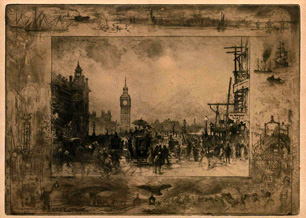
Félix
Buhot
Buhot
 |
Westminster
Bridge orWestminster Clock Tower
etching, aquatint, roulette, and drypoint, 1884, printed in two colors (black for the subject, and bistre for the "symphonic margins"), on medium-heavy toned Holland laid paper, with the Van Gelder watermark, the 6th or 7th state (of 8) following Goodfriend, a fine atmospheric impression with plate tone, with good margins, deckle edges below and right, some uniform light-staining from an old mount, traces of hinges and some soiling on the reverse, otherwise in very good condition
P. 286x397mm., S. 367x446mm.